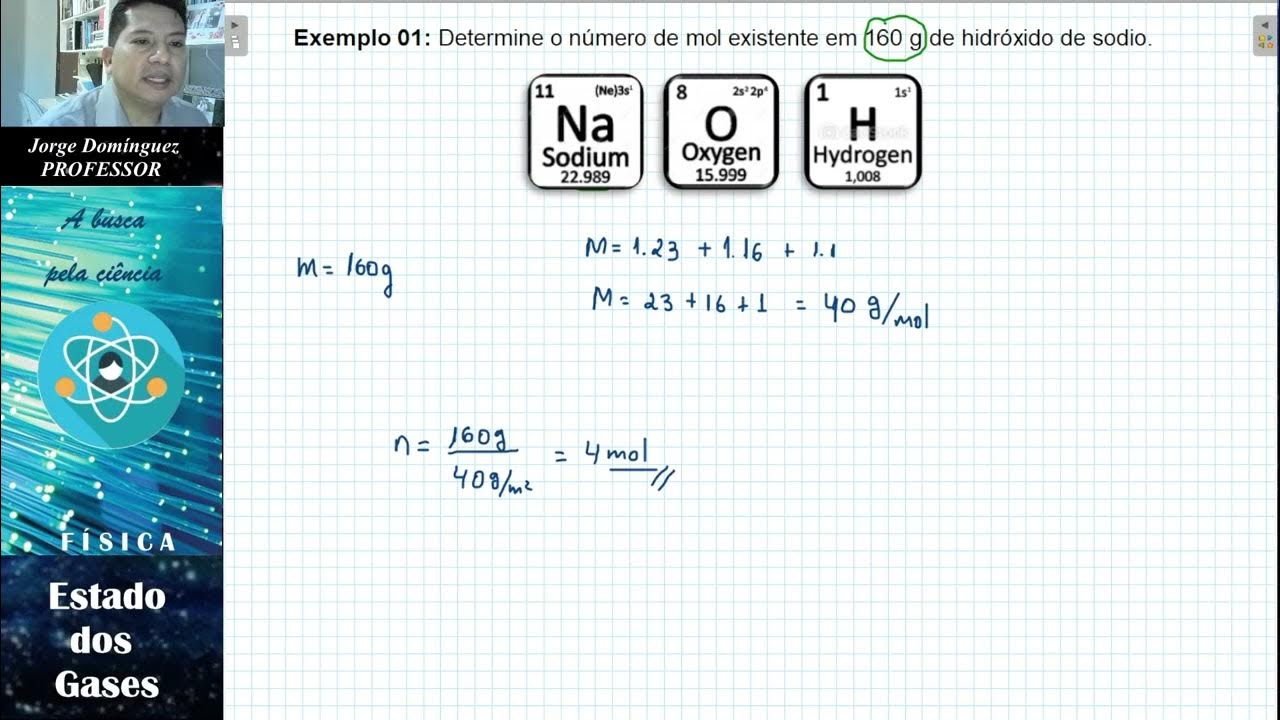TRANSFORMAÇÕES GASOSAS E EQUAÇÃO GERAL DOS GASES - TERMOLOGIA - Aula 12 - Prof Boaro
Summary
TLDRIn this educational video, Professor Marcelo explains the fundamentals of gas transformations and the general gas law in thermodynamics. He discusses key concepts such as isobaric, isothermal, and isovolumetric processes, as well as the behavior of ideal gases, their state variables (pressure, volume, and temperature), and how they interact in different transformations. The video covers important equations, including the ideal gas law, and offers practical examples and exercises to help viewers grasp these concepts. It aims to provide a comprehensive introduction to the principles governing gas behavior and thermodynamic processes.
Takeaways
- 😀 Ideal gases are modeled as particles with no volume or interactions, and all collisions are elastic.
- 😀 Pressure is defined as the force exerted by gas particles on the walls of a container, and it is calculated as force per unit area.
- 😀 Volume in gases is flexible, and gases will expand or contract to fit the volume of the container.
- 😀 Temperature is always measured in Kelvin in thermodynamics, and it is crucial for calculations with gases.
- 😀 The relationship between temperature and volume in gases can be described by the ideal gas law: P1V1/T1 = P2V2/T2.
- 😀 The three main transformations of gases studied are isobaric (constant pressure), isothermal (constant temperature), and isovolumetric (constant volume).
- 😀 Isobaric transformations occur at constant pressure, and the pressure-volume graph is a horizontal line.
- 😀 Isovolumetric transformations involve constant volume, and the pressure-temperature graph is vertical.
- 😀 Isothermal transformations maintain constant temperature, and the pressure-volume graph follows a hyperbolic curve.
- 😀 The equation of state for an ideal gas is often referred to as the ideal gas law, and it can be simplified in special transformations like isothermal or isobaric cases.
- 😀 The lesson emphasizes the importance of understanding how gas transformations and equations relate to each other, with practical applications such as solving problems involving changes in pressure, volume, and temperature.
Q & A
What is the primary focus of the video script?
-The primary focus of the video script is on gas transformations, specifically the isobaric, isometric, and isotermic processes, and the general gas equation (P1V1 = P2V2/T2). It explains the behavior of gases in these transformations and introduces the concept of ideal gases.
What are the three key state variables discussed in the video?
-The three key state variables discussed are pressure, volume, and temperature. These variables are crucial for understanding how gases behave in different transformations.
What does 'isobaric' transformation mean?
-An isobaric transformation is one where the pressure of the gas remains constant. In this process, the gas either expands or contracts, and the volume changes, but the pressure remains unchanged.
What does 'isovolumetric' (or 'isochoric') transformation mean?
-An isovolumetric (or isochoric) transformation is one where the volume of the gas remains constant. In this case, any change in pressure or temperature occurs, but the volume does not change.
What is the key characteristic of an 'isothermal' transformation?
-An isothermal transformation occurs at a constant temperature. During this process, the gas's pressure and volume change in a way that the temperature remains the same. The graph of pressure versus volume in this process forms a hyperbola.
What is the ideal gas law equation presented in the video?
-The ideal gas law equation presented is P1V1/T1 = P2V2/T2. It relates the pressure, volume, and temperature of a gas during a transformation, assuming the gas behaves ideally.
What are the assumptions made about ideal gases in the video?
-Ideal gases are assumed to consist of particles that have no volume, experience only elastic collisions, and do not interact with each other. Their collisions with the walls of the container and with other particles do not result in energy loss.
Why is it important to use Kelvin for temperature in gas calculations?
-It is important to use Kelvin because the temperature scale starts from absolute zero, and negative temperatures are not physically meaningful in gas law equations. The conversion from Celsius to Kelvin is done by adding 273.
How does pressure relate to volume in an isobaric transformation?
-In an isobaric transformation, the pressure remains constant, so the relationship between pressure and volume is not directly affected. However, the volume changes in response to temperature changes while maintaining constant pressure.
What was the example problem discussed in the video about?
-The example problem involved a gas in a small container with an initial volume of 5 liters, an initial temperature of 27°C, and an internal pressure of 12 ATM. The container was then cooled to -23°C, and the volume was assumed constant, so the transformation was isovolumetric. The task was to calculate the final pressure.
Outlines

Dieser Bereich ist nur für Premium-Benutzer verfügbar. Bitte führen Sie ein Upgrade durch, um auf diesen Abschnitt zuzugreifen.
Upgrade durchführenMindmap

Dieser Bereich ist nur für Premium-Benutzer verfügbar. Bitte führen Sie ein Upgrade durch, um auf diesen Abschnitt zuzugreifen.
Upgrade durchführenKeywords

Dieser Bereich ist nur für Premium-Benutzer verfügbar. Bitte führen Sie ein Upgrade durch, um auf diesen Abschnitt zuzugreifen.
Upgrade durchführenHighlights

Dieser Bereich ist nur für Premium-Benutzer verfügbar. Bitte führen Sie ein Upgrade durch, um auf diesen Abschnitt zuzugreifen.
Upgrade durchführenTranscripts

Dieser Bereich ist nur für Premium-Benutzer verfügbar. Bitte führen Sie ein Upgrade durch, um auf diesen Abschnitt zuzugreifen.
Upgrade durchführen5.0 / 5 (0 votes)






